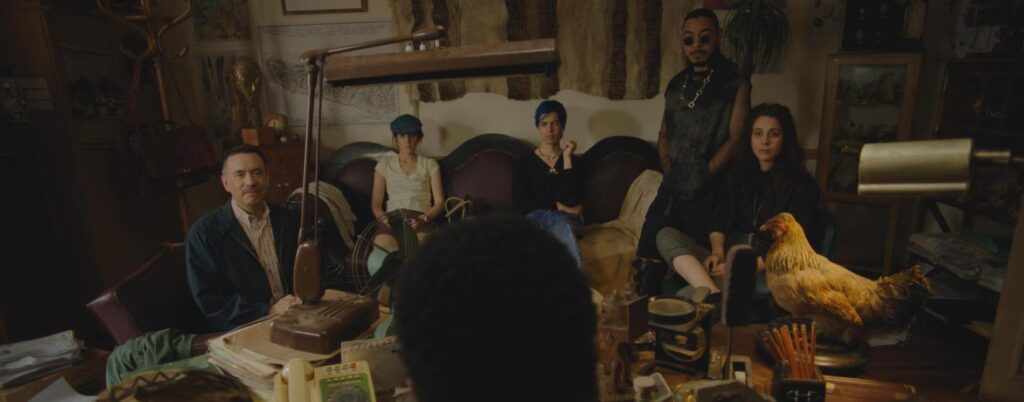“Los Espookys” came out in 2019 and was welcomed by critics and audiences as a strange and wonderful half-hour comedy that blended many things, including English and Spanish. The show is back with a second season this September, featuring guest stars like Yalitza Aparicio and Kim Petras, and bringing more of that unique world created by the writers. It’s a show that returns to a more globalized world, where audiences are hungrier for stories that reflect their own experiences.
Created by Fred Armisen, Julio Torres, and Ana Fabrega, “Los Espookys” follows a group of friends and co-workers as they pursue their passion for producing the spookiest situations for people who request them. These tasks grow more surreal per episode, ranging from staging a dream to get an insomniac to finally fall asleep to orchestrating an eclipse to influence the outcome of an election. The comedy is plentiful but so is the heart, with the show’s characters expanding beyond their initial parameters and becoming a joy to unpeel and spend time with. Most of all, “Los Espookys” is a balm for viewers of mixed backgrounds, used to living with a duality that’s difficult to express. Despite the mystical powers, demons, and parallel realities, “Los Espookys” creates one of the most genuine Latin worlds in recent memory.
HOLA! USA spoke with the show’s creators who provided some insight on the show’s second season, discussing Fabrega’s debut as director, and the process of making a show that feels so in tune with the Latin American experience.
The first season of Los Espookys was released in 2019. How was it to return to season 2 and to get back to these characters?
Fabrega: It was really great to be able to go back and to finish shooting after the pandemic paused production for two years. It felt really nice.
Did you guys have a theme behind season 2? Some characters that you wanted to explore further?
Torres: We had these threads that we were excited to explore. The expansion of the role of the mayor, the idea of this ghostly beauty queen. Yeah, we had these new different worlds that we wanted to play with.
This question is for Ana. How was the experience of directing as well as acting and writing?
It was good. It definitely felt like a lot to do on the days where I was on camera and behind the camera. I think I wouldn’t have done it on another project that I didn’t know so well. I feel like I know this show so well that I felt comfortable moving around in different roles. I wouldn’t have done that on another project. There were days were it definitely would have been easier to be doing one or the other, but it was a great experience.
Are there any differences in making a show that blends English and Spanish and Latin American cultures versus making a show that’s rooted in one place?
Torres: I know that some of my life is in English and some of my life is in Spanish and it feels like I have parallel tracks running on different countries. That felt very true to me. And I think that feels very true to a lot of people too. It might seem like an anomaly to have a show that’s bilingual but that’s so many people’s reality.

Yeah. I feel like when “Los Espookys” came out in 2019, it was kind of unique in that there were no other shows that did what it was doing. Now, I feel like there’s more… I wouldn’t say bilingual shows, but Americans are more exposed to other languages, which is cool.
Torres: Yeah. “Parasite” (The South Korean film that won Best Picture at the Academy Awards) was such a hit. People really love “Veneno” (The HBO Max Spanish show). It’s nice to see that American audiences are doing that.
There’s a lot of surreal elements and magical realism on the show, which is something that I associate with Latin America and Latin American art. Do you guys have any books, TV shows, movies that have inspired or have served as references for your show?
Armisen: I mean, thinking back to when I was a kid, Brazilian and Portuguese soap operas. There was something so surreal about those. I don’t know if it translated directly into the way our show is writen, but it was like a sensibility that kind of stayed alive.
Fabrega: I think more than any specific reference it was a mixture of all the things over the course of our lives. Like, ‘Yeah, there’s a telenovela playing in the background and I’m just kind of subconsciously absorbing it.’ Then those things came out in different ways in the writing of the show.
I also wanted to talk about the show’s guest stars which are such a fun element. These characters feel like they fit the personas of these actors so well. Do you write these roles with the actors in mind?
Fabrega: Yeah, some were written with the actors in mind. We were asking ourselves like, ‘Who’s the Secretary of State’?’ And then it was like ‘Oh, it has to be Kim Petras. Who else would it be?’”
Q: How would you introduce Los Espookys to someone who’s has no idea what it’s about?”
Torres: I think it’s something you have to see in order to get. It’s absurd, it’s fantastical, it’s surprising. It’s one of those things that’s hard to describe.
Fabrega: It feels like trying to describe a painting to someone – ‘Yeah there’s like these colors up on the left. There’s this thing going on on the right.’ Just watch it.

